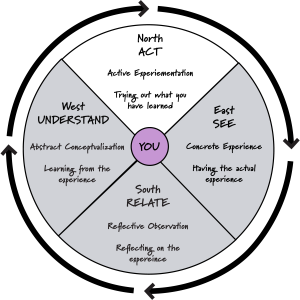
Congratulations on reaching the Finish Point for Module 2! What follows is an opportunity for you to apply your knowledge from Module 2 in a scenario. While watching the following video, think about, and apply what you learned about cultural safety, and being a relational practitioner to a client.
NORTH: ACTIVATING WHAT YOU HAVE LEARNED
You will conclude this learning cycle in the North where you will activate what you have learned through a learning scenario.

Module 2 Finish Point: Learning Scenario
You will see Cecilia in the same video. This time, you will think about Cecilia’s situation and relate her story to the Medicine Wheel and the notion of holistic wellness. You will also be asked to summarize Cecilia’s needs/concerns.
Video Transcript: Cecilia’s Story – Part 1 [Doc]![]()
Drag quotes from Cecilia’s story to the section of the Medicine Wheel that you think is most appropriate. Keep in mind that as human beings, we are not divided equally into four sections and several aspects of our lives may intersect or overlap. While some quotes may fit into more than one area, you can choose what you feel is the most appropriate representation. To work in full-screen click the arrows in the top right hand corner of the activity box.
Keeping Cecilia’s Story in mind, complete the Module 2 Assessment form linked below. This form is required in order to receive your micro-credential badge.

In this module, you have learned about cultural humility and how this is a long-term goal. You analyzed your own self-location and how it relates to your personal understanding of wellness and how this may affect your relationship with clients. Being mindful of the teaching of respect, a health care provider will need to open him/her/themselves to a way of being even though it may be different from their own. To demonstrate respect, the provider will need to understand relationships and how to create the space for partnership to co-construct the most appropriate plan of care for the person. The provider should also be mindful that cultural safety can only be defined by the person receiving care. Miigwech thank you!
Baamaapii! See you again!
To move on to the Module 3, click on the “Next: Module 3 – Wiidooktaadyang as a Way of Being and Self-Determination in Service Delivery →” button at the bottom right hand corner of this page.
References
Nipissing First Nation. (2017, April). Wiidooktaadyang: We are helping one another: A holistic community services approach [Resource manual].

